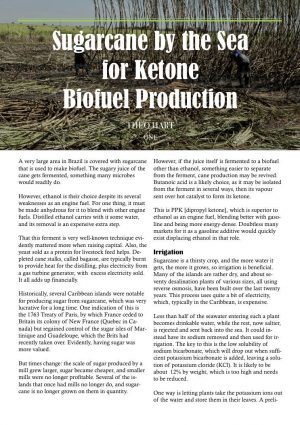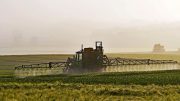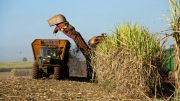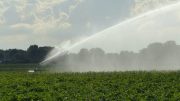 A very large area in Brazil is covered with sugarcane that is used to make biofuel. The sugary juice of the cane gets fermented, something many microbes would readily do.
A very large area in Brazil is covered with sugarcane that is used to make biofuel. The sugary juice of the cane gets fermented, something many microbes would readily do.
However, ethanol is their choice despite its several weaknesses as an engine fuel. For one thing, it must be made anhydrous for it to blend with other engine fuels. Distilled ethanol carries with it some water, and its removal is an expensive extra step.
That this ferment is very well-known technique evidently mattered more when raising capital. Also, the yeast sold as a protein for livestock feed helps. Depleted cane stalks, called bagasse, are typically burnt to provide heat for the distilling, plus electricity from a gas turbine generator, with excess electricity sold. It all adds up financially.
Historically, several Caribbean islands were notable for producing sugar from sugarcane, which was very lucrative for a long time. One indication of this is the 1763 Treaty of Paris, by which France ceded to Britain its colony of New France (Quebec in Canada) but regained control of the sugar isles of Martinique and Guadeloupe, which the Brits had recently taken over. Evidently, having sugar was more valued.
But times change: the scale of sugar produced by a mill grew larger, sugar became cheaper, and smaller mills were no longer profitable. Several of the islands that once had mills no longer do, and sugarcane is no longer grown on them in quantity.
However, if the juice itself is fermented to a biofuel other than ethanol, something easier to separate from the ferment, cane production may be revived. Butanoic acid is a likely choice, as it may be isolated from the ferment in several ways, then its vapour sent over hot catalyst to form its ketone.
This is PPK [dipropyl ketone], which is superior to ethanol as an engine fuel, blending better with gasoline and being more energy-dense. Doubtless many markets for it as a gasoline additive would quickly exist displacing ethanol in that role.
Irrigation
Sugarcane is a thirsty crop, and the more water it gets, the more it grows, so irrigation is beneficial. Many of the islands are rather dry, and about seventy desalination plants of various sizes, all using reverse osmosis, have been built over the last twenty years. This process uses quite a bit of electricity, which, typically in the Caribbean, is expensive.
Less than half of the seawater entering such a plant becomes drinkable water, while the rest, now saltier, is rejected and sent back into the sea. It could instead have its sodium removed and then used for irrigation. The key to this is the low solubility of sodium bicarbonate, which will drop out when sufficient potassium bicarbonate is added, leaving a solution of potassium cloride (KCl). It is likely to be about 12% by weight, which is too high and needs to be reduced.
One way is letting plants take the potassium ions out of the water and store them in their leaves. A preliminary step may be to mix in water already low in potassium ions and so lower their concentration. A good candidate for such removal is water hyacinth (Eichornia crassipes), which floats and grows rapidly. However, it is generally thought a weed difficult to control, so caution might dictate some other plant be selected.
Whichever plant it is, flowing water slowly past them in a lengthy canal should result in the exit water being low in potassium and thus well-suited for irrigation use. These plants lifted from the canal may be sun dried, then compacted into pellets or wafers, and marketed as an organic fertiliser. They would contain plenty of nutrients, in particular nitrogen and potassium.
But it is the leaves that mostly do, and the dried leaves may be separated from the rest — by pin milling and air sorting, for example — to become the fertiliser, while the rest is otherwise made use of. Making furfural is a likely option since bagasse can also be used, as can sargassum gathered from the sea, so enough material for a furfural plant would be available.
Furfural is only made from vegetation, and the two most significant plants in the world, in South Africa and the Dominican Republic, are based on bagasse. The numerous smaller makers, who are mostly Chinese, use maise cobs. An annual output of 5000 tonnes of furfural is usually profitable. Acetic acid is a byproduct.
Making Potassium Bicarbonate
From ordinary potash fertiliser (KCl) can come the potassium bicarbonate needed.
The first step is mixing the dry KCl with a robust sodium acetate solution and then using ethanol to extract potassium acetate, leaving NaCl behind. Next: gas the alcoholic extract with CO2 to drop out potassium carbonate, which is not soluble in ethanol. About half the potassium reacts this way, while the rest gets an acetic acid molecule somewhat firmly attached.
This rather surprising result was disclosed in an old British patent [521 202]. Heat will drive off the acid, and contacting it with sodium bicarbonate will provide the sodium acetate wanted in the first step. Potassium bicarbonate is readily enough got from its carbonate.
A stand-alone plant is conceivable, so buy potash fertiliser and soda and then sell potassium bicarbonate. Acetic acid would simply circulate, but a source of CO2 would be needed. Some quantity buyers of this bicarbonate would be mixing it with ordinary salt to get sodium bicarbonate (and soda also if they want), plus KCl, the usual potash fertiliser.
Exports of potassium bicarbonate to several countries would likely be possible, where some local businessperson could supply the local market with washing soda.
Theo Hart





